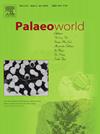New conodont fauna from the Floian (Lower Ordovician) Acoite Formation, Cordillera Oriental, Argentina
IF 1.7
3区 地球科学
Q2 PALEONTOLOGY
引用次数: 0
Abstract
This contribution reports a new species, Trapezognathus morenensis n. sp., from the upper levels of the Acoite Formation outcropping in the El Moreno area of the Cordillera Oriental, northwestern Argentina. This species occurs together with Trapezognathus diprion, Costiconus sp., Drepanodus arcuatus, Drepanoistodus costatus, D. forceps, D. pitjanti, Erraticodon patu, Gothodus costulatus, G. andinus, Kallidontus sp., Paltodus subaequalis, Parapanderodus cf. striatus, Paroistodus parallelus, Protopanderodus rectus, Zentagnathus argentinensis, Gothodus spp., and Drepanoistodontid gen. et sp. indet. Trapezognathus morenensis n. sp. exhibits intermediate characteristics between T. diprion and T. quadrangulum, and also displays a close relationship with early species of the genus Baltoniodus. The conodont assemblage allows for the identification of the Gothodus andinus and Trapezognathus diprion zones, indicating a middle to late Floian (Early Ordovician) age. In addition, the boundary between the Gothodus andinus Zone and the succeeding Trapezognathus diprion Zone is defined by the first occurrence datum of Trapezognathus diprion within the same stratigraphic section, representing the first documented instance of this boundary. The revision of associated taxa with reported Trapezognathus spp. suggests that the definition of the Floian–Dapingian boundary still requires verification in the Cordillera Oriental of Argentina.
阿根廷东部科迪勒拉弗洛ian(下奥陶统)Acoite组牙形石新动物群
本文报道了阿根廷西北部东部科dillera地区El Moreno地区Acoite组露头上层的一新种Trapezognathus morenensis n. sp.。该种与Trapezognathus diprion、Costiconus sp.、arcuatus Drepanoistodus、costatus Drepanoistodus、D. forceps、D. pitjanti、Erraticodon patu、Gothodus costulatus、G. andinus、Kallidontus sp.、Paltodus subaequalis、paratanderodus cfstriatus、paristodus parallelus、Protopanderodus rectus、Zentagnathus argentinensis、Gothodus sp.和Drepanoistodontid gen. et sp. indet一起发生。摘要Trapezognathus morenensis具有介于diprion和quadrangulum之间的中间特征,并与Baltoniodus属的早期物种有密切的亲缘关系。牙形石组合可以识别出Gothodus andinus和Trapezognathus diprius带,表明其时代为弗洛世中晚期(早奥陶世)。此外,Gothodus andinus带与随后的Trapezognathus diprion带之间的边界是由同一地层剖面内的首次Trapezognathus diprion产状基准线确定的,这是该边界的首次文献记录实例。与已报道的Trapezognathus spp.相关分类群的修正表明,在阿根廷东部科迪勒拉,弗洛ian - dapingian界线的定义仍有待验证。
本文章由计算机程序翻译,如有差异,请以英文原文为准。
求助全文
约1分钟内获得全文
求助全文
来源期刊

Palaeoworld
PALEONTOLOGY-
CiteScore
4.00
自引率
5.90%
发文量
95
期刊介绍:
Palaeoworld is a peer-reviewed quarterly journal dedicated to the study of past life and its environment. We encourage submission of original manuscripts on all aspects of palaeontology and stratigraphy, comparisons of regional and global data in time and space, and results generated by interdisciplinary investigations in related fields. Some issues will be devoted entirely to a special theme whereas others will be composed of contributed articles. Palaeoworld is dedicated to serving a broad spectrum of geoscientists and palaeobiologists as well as serving as a resource for students in fields as diverse as palaeobiology, evolutionary biology, taxonomy and phylogeny, geobiology, historical geology, and palaeoenvironment.
Palaeoworld publishes original articles in the following areas:
•Phylogeny and taxonomic studies of all fossil groups
•Biostratigraphy, chemostratigraphy, chronostratigraphy
•Palaeoecology, palaeoenvironment and global changes throughout Earth history
•Tempo and mode of biological evolution
•Biological events in Earth history (e.g., extinctions, radiations)
•Ecosystem evolution
•Geobiology and molecular palaeobiology
•Palaeontological and stratigraphic methods
•Interdisciplinary studies focusing on fossils and strata
 求助内容:
求助内容: 应助结果提醒方式:
应助结果提醒方式:


